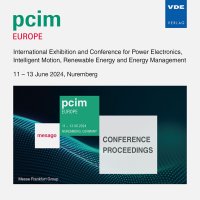Analysis of Inverter Operation Modes of an IGBT-Based ZCS LLC Converter for a 2 kW Automotive On-Board DC-DC
Konferenz: PCIM Europe 2024 - International Exhibition and Conference for Power Electronics, Intelligent Motion, Renewable Energy and Energy Management
11.06.2024-13.06.2024 in Nürnberg, Germany
doi:10.30420/566262304
Tagungsband: PCIM Europe 2024
Seiten: 10Sprache: EnglischTyp: PDF
Autoren:
Urbaneck, Daniel; Wiegard, Jan; Schafmeister, Frank
Inhalt:
State-of-the-art LLC resonant converters use MOSFETs in their inverter stage, allowing high switching frequencies and thus the use of compact magnetic components. The large parasitic output capacitance and the poor reverse-recovery behaviour of the inherent body diode of high-voltage (600 V) silicon MOSFETs require soft switching, i.e. zero-voltage switching (ZVS) in half- and full-bridge configurations. Otherwise, the high turn-on switching losses would lead to excessive heating and the destruction of the switch. Therefore, MOSFET-based LLC converters are operated in the so-called inductive region only, which enables ZVS. The use of robust and cost-effective IGBTs instead of MOSFETs is particularly advantageous for automotive applications, since in addition to high reliability low costs are an important objective here. Since IGBTs are characterized by dominant turn-off losses and generally higher switching losses compared to MOSFETs, the aim is to operate them with zero-current switching (ZCS) and at lower overall switching frequencies. In the capacitive operation region of the LLC converter, both requirements are fulfilled. In this region also, the voltage transfer characteristic is steeper, which qualifies for applications with a strongly varying input-to-output voltage ratio, such as given for automotive on-board DC-DC converters connecting the high-voltage traction battery with the 12 V auxiliary battery. In thispaper, a stress value analysis based on a switched-model simulation is used to design a ZCS LLCconverter and take advantage of the mentioned benefits of IGBTs as well as of the steeper voltagetransfer characteristic. A full-bridge inverter stage is employed, which can be operated in full-bridge, half-bridge or phase-shifted full-bridge mode. The efficiency of MOSFET-based ZVS LLC converter can beincreased for applications with strongly varying voltage transfer ratios (as described above), by applyingthe mentioned inverter operation modes. However, the analysis of loss mechanisms of the IGBT-based ZCS LLC shows that the simple and robust full-bridge operation is globally the most efficient operatingmode here. The main cause are the higher switching losses of the inverter stage in half-bridge andphase-shifted full-bridge operation mode.


